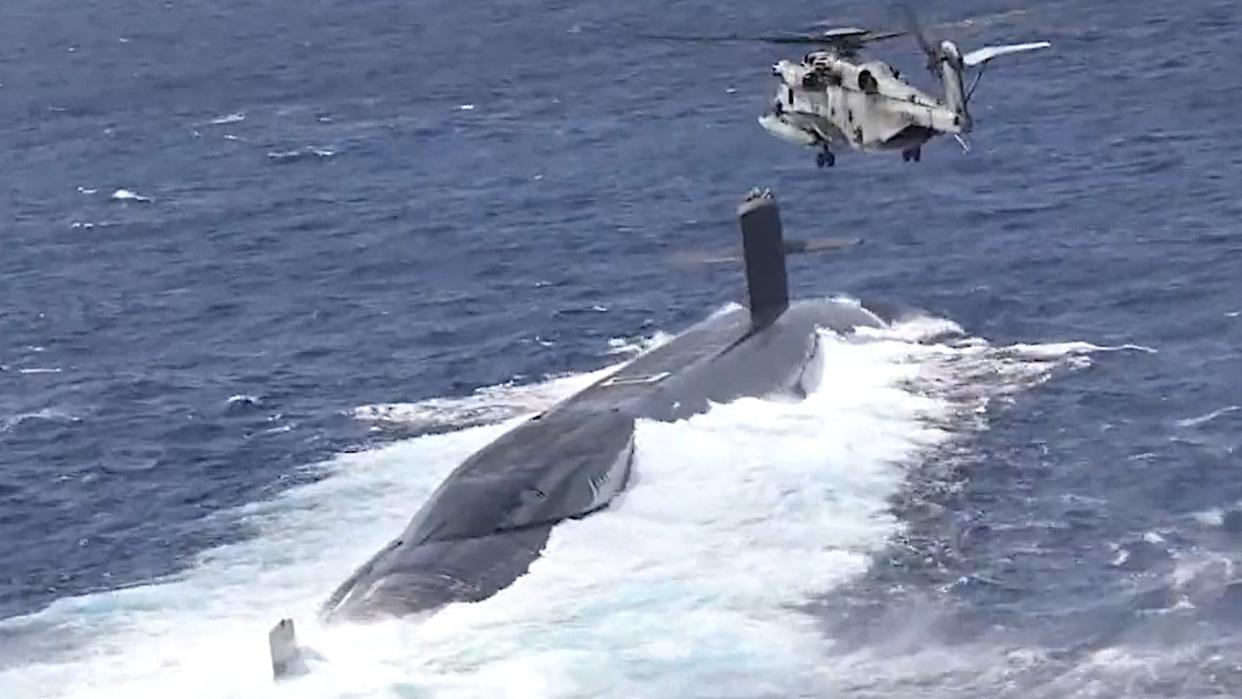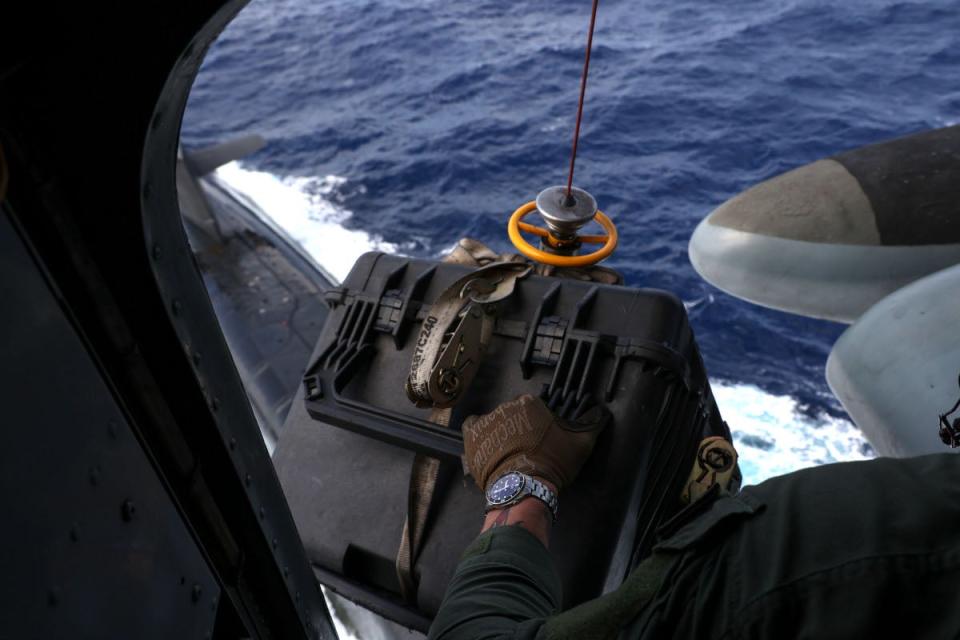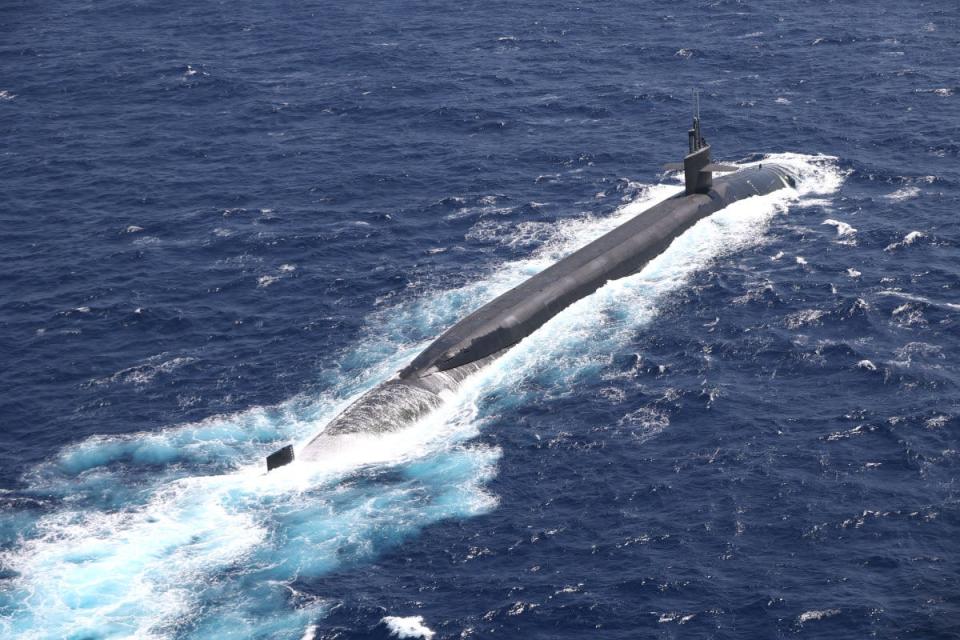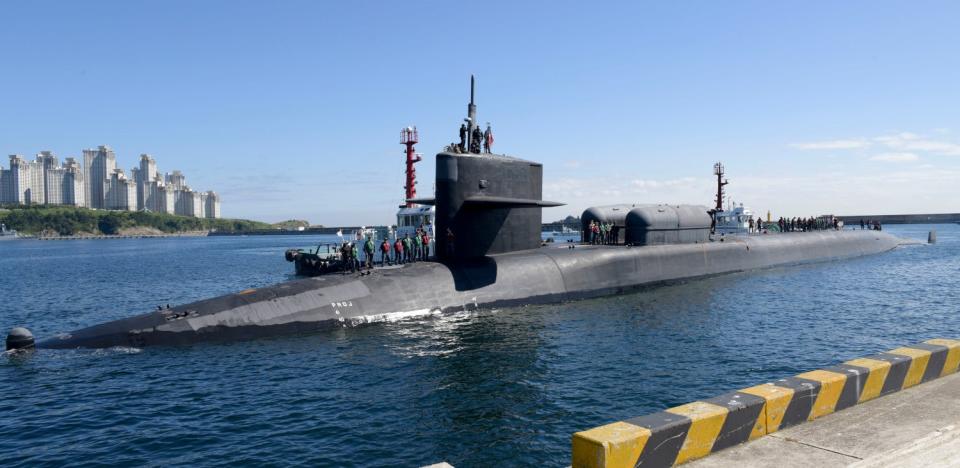No More Silent Service As Marine CH-53s Resupply Ballistic Submarine In Pacific

The U.S. Navy's top submarine officer in the Pacific has said that his forces are no longer just "a silent service" in a recent interview with Breaking Defense. This reflects an increasing willingness by the Navy to discuss the activities of its Ohio class missile submarines and other types to help deter potential adversaries, particularly China. An announcement today from the U.S. Marine Corps about resupplying an Ohio class ballistic missile submarine, or SSBN, in the Philippine Sea using CH-53E Super Stallion helicopters reflects this policy shift and highlights new concepts of operations.
The U.S. Marine Corps' III Marine Expeditionary Force (III MEF), headquartered on the Japanese island of Okinawa, issued a press release about the recent vertical replenishment of the Ohio class SSBN USS Maine in the Philippine Sea earlier today. Two CH-53Es from Marine Heavy Helicopter Squadron 462 (HMH-462), part of III MEF's 1st Marine Aircraft Wing (1st MAW), carried out the recent replenishment mission. Cargo was lowered down to the submarine via hoists on the helicopters.
The Navy currently has 14 Ohio SSBNs in service, which form the sea-based leg of America's nuclear deterrence triad. The service has four other Ohios converted into conventionally-armed guided missile submarines. Those boats are capable of carrying up to 154 Tomahawk cruise missiles, as well as serving as motherships for special operations forces and uncrewed platforms, underwater command and intelligence fusion centers, and more, as detailed in this past War Zone feature.
"1st MAW’s persistent and forward presence makes it the backbone of the Stand-in-Force’s
expeditionary capability," U.S. Marine Corps Col. Christopher Murray, head of the Marine Aircraft Group 36 (MAG-36), part of 1st MAW based in Okinawa, said in a statement. "The intricacies of seamlessly sustaining the force through naval integration and aviation-delivered logistics is a testament to our adaptability, readiness, and ability to project power within the Indo-Pacific."

The concept of a "Stand-in-Force," or SiF, that can operate effectively within an opponent's so-called "Weapons Engagement Zone" is a central component of the Marine Corps' Expeditionary Advance Base Operations (EABO) concept. The service is still in the process of refining EABO, but it is focused on the idea of relatively small, but still robust Marine task forces being able to rapidly deploy to remote or austere forward locations, establish temporary bases to hold enemy forces in the area at risk, and then be just as capable of redeploying as the situation demands. The Corps has made clear that readily deployable aviation contingents, including F-35B Joint Strike Fighters, MV-22B Ospreys, and helicopters, as well as ground-based stand-off strike capabilities, will be key enablers of these concepts of operations.
The Marines have already been exploring other ways that forces might be able to contribute to larger operations using the EABO concept. This includes supporting anti-submarine warfare missions and using forward bases as critical logistics nodes inside contested environments.
Marine units resupplying Navy submarines, including Ohio SSBNs, might be another way to leverage EABO. At-sea replenishment of submarines in forward areas could be valuable for ensuring interrupted deployments, or even extending them, in the midst of a crisis or contingency.

"The U.S. Navy's ballistic missile submarine force has demonstrated yet again that we have the proven capability to work seamlessly alongside III Marine Expeditionary Force to execute our mission, allowing us to remain on station," Navy Cmdr. Travis L. Wood, the USS Maine's commanding officer, said in a statement about the recent vertical replenishment of his boat in the Philippine Sea. "Rotary-wing vertical replenishment such as this allow us to quickly resupply so that we can constantly maintain pressure against any adversary who would wish to do harm to the homeland."
The Navy's interest in this kind of resupply capability for its forward-deployed submarines has been apparent for some time now. The service has demonstrated the potential to use various aircraft, including Air Force C-17A Globemaster III cargo planes, Marine MV-22 tilt-rotors, and Navy MH-60 Sea Hawk helicopters and drones, for these kinds of missions in recent years. Even platforms with limited capacity could still be used to deliver vital spare parts, medical supplies, or other cargo to submarines, as well as other ships, at sea.
This all comes amid an increasing willingness of the part of the Navy to disclose where its submarines are and what they are doing, in general. This is a trend that The War Zone has been very actively tracking in recent years. The service has historically been tight-lipped about submarine forces, often referred to as the "Silent Service." The Navy's various classes of submarines inherently provide discreet platforms capable of conducting a host of missions, including stand-off strikes, intelligence-gathering, special operations support, and more, even inside denied or otherwise sensitive areas.
"I would no longer characterize ourselves as a silent service," Navy Rear Adm. Jeffrey Jablon, who is currently commander of Submarine Force, U.S. Pacific Fleet (SUBPAC), told author and defense expert Robbin Laird earlier this year according to a piece Breaking Defense published last week. "Deterrence is a major mission for the submarine force You can’t have a credible deterrent without communicating your capabilities; if the adversary doesn’t know anything about that specific deterrent, it’s not a deterrent."
Jablon's viewpoint here is particularly notable in the context of Ohio SSBNs and deterrence given that those boats are often touted as the most survivable leg of the U.S. nuclear triad given their ability to effectively disappear for months at a time.
Laird said that Jablon told him during the interview that, at that time, there were 18 unspecified Navy submarines sailing across the full expanse of the Pacific Ocean, seven of which were conducting operations west of the international dateline. That part of the Pacific includes the Philippine Sea where the recent vertical replenishment of USS Maine occurred.

"The submarine force is now becoming part of the ‘combat clusters’ that you’re talking about instead of an independent operator. In the Cold War, we operated independently, alone, and unafraid," Jablon explained to Laird, who also said the SUBPAC commander specifically highlighted work with the Marines using the EABO concept. "During the land wars, we started becoming part of the joint force as we provided land fires via the TLAM [Tomahawk Land Attack Missile]. Now, we are fully integrated with the joint force in terms of targeting and communications. But, of course, we can also conduct independent operations as the ‘silent service’ when directed."
In the Pacific, the major target of any U.S. deterrence efforts, broadly, is dissuading the Chinese government from engaging in various malign activities. Concerns have been growing in recent years across the U.S. government about the potential for a Chinese military intervention against Taiwan well before the end of the decade.
However, China is not the only country the U.S. military seeks to deter in the Pacific, including through the increasing disclosures about Navy submarines in the region, especially Ohio class SSBNs and SSGNs. For instance, public submarine deployments and other shows of force are often meant to send signals to North Korea. They have the added effect of helping to reassure American allies and partners, too.
Just last month, President Joe Biden, speaking alongside his South Korean counterpart Yoon Suk Yeol, announced plans for more port visits in that East Asian country involving unspecified Navy "nuclear submarines." Reports at the time said that this could include the first visit by an Ohio SSBN to the Pensinal in some four decades. Ohio SSGNs have made stops in South Korea more recently than that. This was all part of a new expanded nuclear-deterrence-focused security framework called the Washington Declaration, which you can read more about here.

U.S. submarine operations in the Pacific, as well as those conducted by its allies, have gained new attention in recent years due to the Australia-United Kingdom-United States (AUKUS) security agreement. A major component of this has been expanding Australia's submarine capabilities. The Australian government currently plans to buy at least three U.S.-made nuclear-powered Virginia class boats and pursue a domestically-developed nuclear-powered design with American and British assistance.
Submarine activity in the Pacific overall has been more and more of a hot topic. China's People's Liberation Army Navy continues to expand the size and capabilities of its own submarine fleets, which includes a growing number of Type 094 SSBNs. There is evidence that the PLAN is increasing the scale and scope of its routine SSBN operations, as well.
With regard to U.S. Navy submarines, and the service's increasing disclosure of their movements, this all extends well beyond the Pacific. There has been a similar surge in publicly announced U.S. submarine activity in and around Europe and the Middle East in recent years that has looked clearly intended to send signals to Russia and Iran, respectively.
All told, the recent use of Marine CH-53Es to resupply the USS Maine in the Philippine Sea is a demonstration of what could be a very useful capability in various scenarios in the future. At the same time, the public disclosure of the at-sea replenishment mission, and of Maine's presence in the region at all, reflects a larger change in the Navy's willingness to talk openly about its submarine activities to help deter opponents in the Pacific and beyond.
Contact the author: joe@thedrive.com

